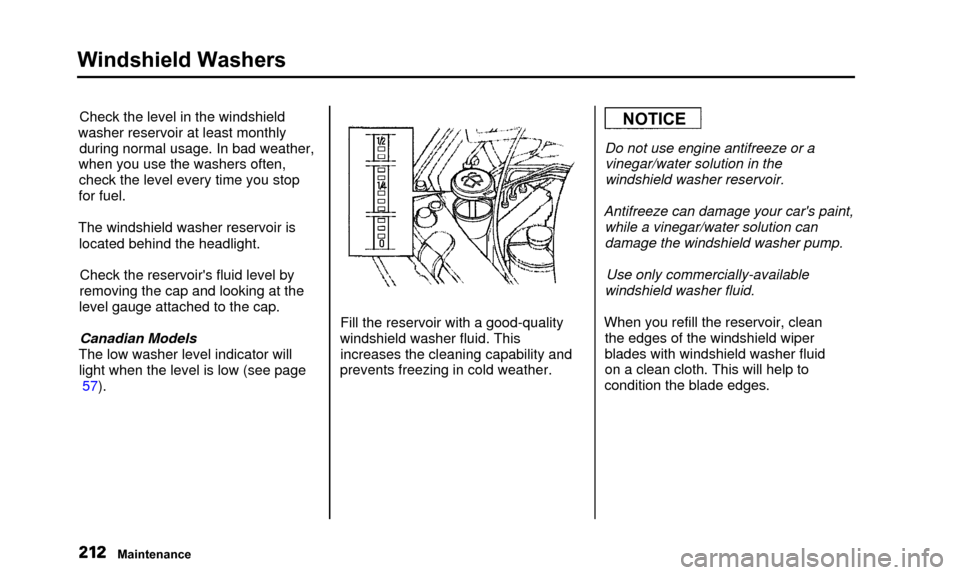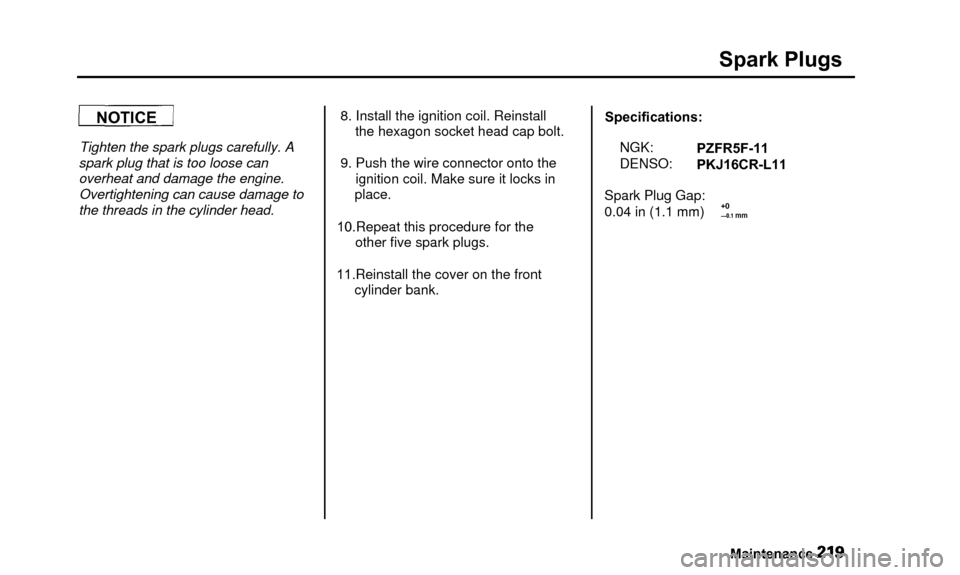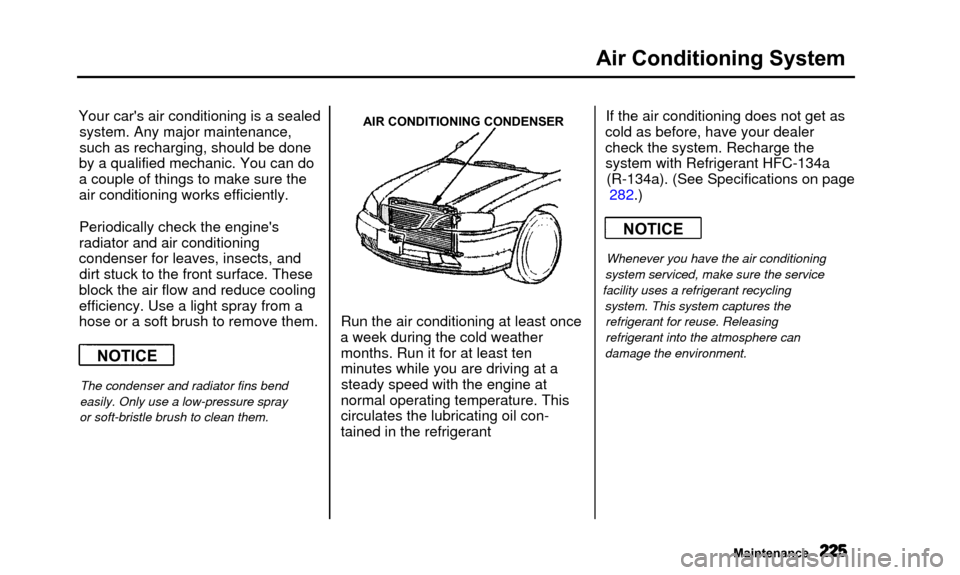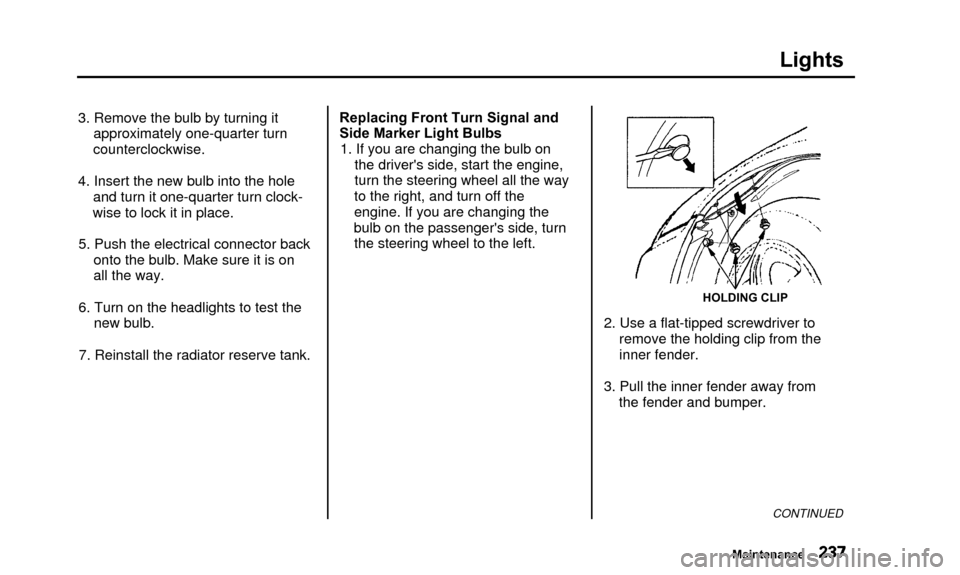engine Acura TL 2000 3.2 Repair Manual
[x] Cancel search | Manufacturer: ACURA, Model Year: 2000, Model line: TL, Model: Acura TL 2000Pages: 311, PDF Size: 3.05 MB
Page 215 of 311

Windshield Washers
Check the level in the windshield
washer reservoir at least monthly during normal usage. In bad weather,
when you use the washers often, check the level every time you stop
for fuel.
The windshield washer reservoir is located behind the headlight.
Check the reservoir's fluid level by
removing the cap and looking at the
level gauge attached to the cap.
Canadian Models
The low washer level indicator will light when the level is low (see page 57). Fill the reservoir with a good-quality
windshield washer fluid. This increases the cleaning capability and
prevents freezing in cold weather.NOTICE
Do not use engine antifreeze or a vinegar/water solution in the
windshield washer reservoir.
Antifreeze can damage your car's paint, while a vinegar/water solution can
damage the windshield washer pump.
Use only commercially-available
windshield washer fluid.
When you refill the reservoir, clean the edges of the windshield wiper
blades with windshield washer fluid
on a clean cloth. This will help to
condition the blade edges.
Maintenance
Page 216 of 311

Transmission Fluid
Automatic Transmission
DIPSTICK
Check the fluid level with the engine
at normal operating temperature.1. Park the car on level ground. Shut off the engine.
2. Remove the dipstick (yellow loop) from the transmission and wipe it
with a clean cloth.
UPPER MARK
LOWER MARK
3. Insert the dipstick all the way into the transmission securely asshown in the illustration.
4. Remove the dipstick and check the fluid level. It should be
between the upper and lowermarks. 5. If the level is below the lower
mark, add fluid into the tube to
bring it to the upper mark. Always use Honda Premium Formula
Automatic Transmission Fluid (ATF). If it is not available, you
may use a DEXRON® III
automatic transmission fluid as a
temporary replacement. However,
continued use can affect shift
quality. Have the transmission drained and refilled with Honda
ATF as soon as it is convenient.
6. Insert the dipstick all the way back into the transmission securely as
shown in the illustration.
The transmission should be drained and refilled with new fluid according
to the time and distance recommen- dations in the maintenance schedule.
Maintenance
Page 218 of 311

Power Steering, Hood Latch
Power Steering
MAX
Check the level when the engine is
cold. Look at the side of the
reservoir. The fluid should be
between the UPPER LEVEL and LOWER LEVEL. If it is below the
LOWER LEVEL, add power steering
fluid to the UPPER LEVEL. Always use Genuine Honda Power
Steering Fluid. If it is not available,
you may use another power steering
fluid as an emergency replacement. However, continued use can cause
increased wear and poor steering in
cold weather. Have the power steering system flushed and refilled
with Honda PSF as soon as possible.
A low power steering fluid level can indicate a leak in the system. Check
the fluid level frequently and have
the system inspected as soon as
possible.
Turning the steering wheel to full left
or right lock and holding it there can
damage the power steering pump.
Hood Latch
Clean the hood latch assembly with a
mild cleaner, then lubricate it with a
multipurpose grease. Lubricate all
the moving parts, including the pivot.
Follow the time and distance
recommendations in the
Maintenance Schedule. If you are
not sure how to clean and grease the
latch, contact your Acura dealer.
Maintenance
NOTICE
Page 219 of 311

Air Cleaner Element
The air cleaner element should becleaned or replaced according to thetime and distance recommendations
in the maintenance schedule.
Cleaning (Severe Conditions)
Clean the air cleaner element by
blowing compressed air through it in
the opposite direction to normal air
flow. If you do not have access to
compressed air (such as a service station), ask your Acura dealer to do
this service.
Follow the replacement procedure
for removal and reinstallation.
Replacement
The air cleaner element is inside the air cleaner housing on the driver's
side of the engine compartment
To replace it:BOLTS
1. Loosen the four bolts and remove the air cleaner housing cover.
2. Remove the old air cleaner element.
3. Carefully clean the inside of the air cleaner housing with a damp
rag.
AIR CLEANER ELEMENT
4. Place the new air cleaner element in the air cleaner housing.
5. Reinstall the air cleaner housing cover, tighten the four bolts.
Maintenance
Page 222 of 311

Spark Plugs
Tighten the spark plugs carefully. A
spark plug that is too loose can
overheat and damage the engine. Overtightening can cause damage to
the threads in the cylinder head. 8. Install the ignition coil. Reinstall
the hexagon socket head cap bolt.
9. Push the wire connector onto the ignition coil. Make sure it locks in
place.
10.Repeat this procedure for the other five spark plugs.
11.Reinstall the cover on the front cylinder bank. Specifications:
NGK:
DENSO: PZFR5F-11
PKJ16CR-L11
Spark Plug Gap:
0.04 in (1.1 mm)
Maintenance
NOTICE
+0—0.1 mm
Page 228 of 311

Air Conditioning System
Your car's air conditioning is a sealedsystem. Any major maintenance,
such as recharging, should be done
by a qualified mechanic. You can do
a couple of things to make sure the
air conditioning works efficiently.
Periodically check the engine's
radiator and air conditioning
condenser for leaves, insects, and dirt stuck to the front surface. These
block the air flow and reduce cooling
efficiency. Use a light spray from a
hose or a soft brush to remove them.
The condenser and radiator fins bend
easily. Only use a low-pressure spray
or soft-bristle brush to clean them. AIR CONDITIONING CONDENSER
Run the air conditioning at least once
a week during the cold weather months. Run it for at least ten
minutes while you are driving at asteady speed with the engine at
normal operating temperature. This
circulates the lubricating oil con-
tained in the refrigerant If the air conditioning does not get as
cold as before, have your dealer
check the system. Recharge the system with Refrigerant HFC-134a (R-134a). (See Specifications on page 282.)
Whenever you have the air conditioning
system serviced, make sure the service
facility uses a refrigerant recycling system. This system captures therefrigerant for reuse. Releasing
refrigerant into the atmosphere can
damage the environment.
Maintenance
NOTICE
NOTICE
Page 240 of 311

Lights
3. Remove the bulb by turning itapproximately one-quarter turn
counterclockwise.
4. Insert the new bulb into the hole and turn it one-quarter turn clock-
wise to lock it in place.
5. Push the electrical connector back onto the bulb. Make sure it is onall the way.
6. Turn on the headlights to test the new bulb.
7. Reinstall the radiator reserve tank. Replacing Front Turn Signal and
Side Marker Light Bulbs
1. If you are changing the bulb on the driver's side, start the engine,
turn the steering wheel all the way
to the right, and turn off the
engine. If you are changing the
bulb on the passenger's side, turn the steering wheel to the left.
HOLDING CLIP
2. Use a flat-tipped screwdriver to remove the holding clip from the
inner fender.
3. Pull the inner fender away from the fender and bumper.
CONTINUED
Maintenance
Page 246 of 311

Storing Your Car
If you need to park your car for an
extended period (more than one
month), there are several things youshould do to prepare it for storage.
Proper preparation helps prevent deterioration and makes it easier to
get your car back on the road. If
possible, store your car indoors.
• Fill the fuel tank.
• Change the engine oil and filter (see page 203).
• Wash and dry the exterior completely.
• Clean the interior. Make sure the carpeting, floor mats, etc. are
completely dry.
• Leave the parking brake off. Put the transmission in Park. • Block the rear wheels.
• If the car is to be stored for a
longer period, it should besupported on jackstands so the
tires are off the ground.
• Leave one window open slightly (if the car is being stored indoors).
• Disconnect the battery. • Support the front wiper blade arms with a folded towel or rag so
they do not touch the windshield.
• To minimize sticking, apply a silicone spray lubricant to all door
and trunk seals. Also, apply a
vehicle body wax to the painted surfaces that mate with the door
and trunk seals. • Cover the car with a "breathable"
cover, one made from a porous
material such as cotton.
Nonporous materials, such as
plastic sheeting, trap moisture,
which can damage the paint.
• If possible, run the engine for a while periodically (preferably oncea month).
If you store your car for 12 months or longer, have your Acura dealer
perform the inspections called for in
the 24 months/30,000 miles (48,000
km) maintenance schedule (Normal Conditions) as soon as you take it
out of storage (see page 192). The
replacements called for in the maintenance schedule are not
needed unless the car has actually
reached that time or mileage.
Maintenance
Page 256 of 311

Taking Care of the Unexpected
This section covers the more-common problems that motorists
experience with their vehicles. It
gives you information about how to safely evaluate the problem and what
to do to correct it. If the problem has stranded you on the side of the road,
you may be able to get going again. If not, you will also find instructions
on getting your car towed. Compact Spare Tire.................... 254
Changing a Flat Tire.................. 255
If Your Engine Won't Start............ 260
Nothing Happens or theStarter Motor OperatesVery Slowly...................... 261
The Starter Operates
Normally.......................... 262
Jump Starting............................ 262
If Your Engine Overheats.............. 265
Low Oil Pressure Indicator.......... 267 Charging System Indicator........ 268
Malfunction Indicator Lamp ........ 269
Brake System Indicator .............. 270
Closing the Moonroof.............. 271
Fuses.............................................. 272
Checking and Replacing.......... 273
Emergency Towing ...................... 277
Taking Care of the Unexpected
Page 263 of 311

Changing a Flat Tire, If Your Engine Won't Start
20. Store the jack in its holder. Turnthe jack's end bracket to lock it in
place. Replace the cover. Store the
tools.
Loose items can fly around the
interior in a crash and could
seriously injure the occupants.
Store the wheel, jack and tools
securely before driving.
21. Store the center cap in the trunk.
Make sure it does not get scratch-
ed or damaged. 22. Unclip the hook from the trunk lid
and lower the trunk floor.
23. Close the trunk lid. If Your Engine Won't Start
Diagnosing why your engine won't
start falls into two areas, depending
on what you hear when you turn the
key to START (III):
• You hear nothing, or almost nothing. The engine's starter
motor does not operate at all, oroperates very slowly.
• You can hear the starter motor operating normally, or the starter
motor sounds like it is spinning
faster than normal, but the engine does not start up and run.
Taking Care of the Unexpected